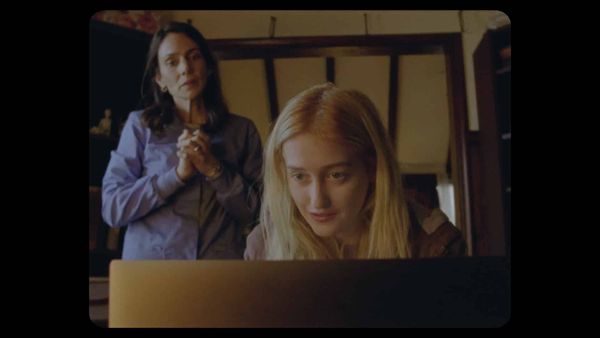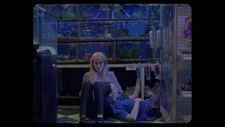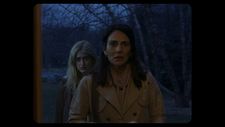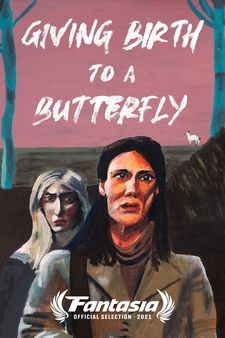 |
| Giving Birth To A Butterfly Photo: Fantasia International Film Festival |
It is, without doubt, one of the most unusual films at 2021’s Fantasia International Film Festival, and one that viewers won’t forget in a hurry. Following Diana (Annie Parisse), a woman who, upon realising she has been the victim of an internet scam, embarks on a road trip with her son’s girlfriend which takes her to some very strange places, Giving Birth To A Butterfly has a distinctive look, a quirky sense of humour and a surprising amount of philosophical weight. After I bumped into director Theodore Schaeffer (generally known as Ted) at a karaoke night at the festival, we agreed to do an interview so that he could talk about how this strange beast originally emerged from its chrysalis.
“My writing partner Patrick Lawler and I have been working together now for eight years, and we have a lot of scripts,” he begins. “And this is as much us as it can be. So it's hard. It just feels like the most honest way for us to express the ideas we're trying to deal with. He's also a poet, so that, well...”
That makes sense, I tell him. To me, so much of it is sitcom-like in the set-up that it feels like an episode of a sitcom that goes off message and does its own thing.
“Yeah, very much,” he says. “Somebody talked about it like this: it's like an American nightmare. I was like, ‘Oh, that makes sense.’ I don't think I had made that exact connection. But it is because it's so much about the American dream in various forms. And while there are sitcoms everywhere, it feels inherently so much like an American creation, and like this idealised version of the family. It exists in this off kilter world in which maybe it's not as ideal as the characters hope that it is.”
 |
| Gus Birney and Kelley Van Dilla in the pet shop Photo: Fantasia International Film Festival |
The sitcom idea seems to fit with his decision to film it in square format. What was the thinking behind that?
“Some of its based on the kind of films we were looking at,” he says. “And we were talking about the way it helps, especially in, you know, on location shooting, with the ability of what you can and can't show by confining the height as opposed to the width. You can hide a lot more, and you can be more selective about what you're showing. But also, it is a film about people who are sort of trapped within a sort of created page or box or whatever. And literally putting it within a box felt like it made the most sense.”
The film has a very distinctive colour scheme as well, a pastel aesthetic Was that something that he chose for this particular film or that he was interested in working with more generally?
“Probably both, I think. For this, and especially on 16 [mm film], I just love the way it captures that sort of pastel, muted colour scheme. It just made sense to me. And we kind of mapped out how we imagine what sort of colours made sense within the characters, and had this idea of grounding it in earth tones. And as the film progresses, the colours change a little bit, like when you get to the Ninas’ house, there's not really any green in the film until then. And then there's all this green and yellow. There's a lot of the idea of cycles of life within nature, where you have this sort of barren landscape that then starts to bloom slowly.”
Talking of nature, there are a lot of animals in the film doing one thing or another. Back at that karaoke night, people were talking about the the cat that he managed to capture in a perfect shot. Did he just spend a lot of time filming animals until he got the right bits that he could edit in?
“We did,” he says. “There are a couple of other animals that did not make it in the film, that we found, but that one was sort of planned. We found that cat that just kind of lives around the gas station. And so we hadn't planned it out but that was the perfect way to do it. It took a while but that cat was pretty good. It basically did the same thing every take.
“You know, we rehearsed a lot especially as we're shooting film, we don't have a lot of money. There was such an emphasis on rehearsing and rehearsing until we felt really comfortable with it and really confident about what we were going to do. So the cat, you know, we waited until the camera felt confident and then we started testing it out with a camera and it just seemed pretty game.”
And then there are all the animals in the pet shop. Did they try to capture particular behaviours from them, or just take what they could get?
“A little of both, especially with Homer,” he says, referring to a particularly charismatic fish who was nonetheless cautious to begin with. “He wouldn't move too much. We had to kind of wait and coax him out and slowly he started to become a little more friendly and out and about. Yeah, we wanted it to feel like there was miscommunication between the two sort of worlds.”
Having talked about the animals, we go on to discuss the humans in the film, and the casting process.
“We had a great casting director [Kate Geller] and we met with people we thought understood the material and kind of got to the character, understood what they needed to do to bring the character to life. I mean, I met with Annie for coffee and I think we spent like three hours just talking about the film and about other things. And it became so immediately apparent, I was like, ‘Well, this person is just so perfectly embodying exactly what I imagined as this character, and the same thoughts.’ And then Paul [Sparks, who plays Diana’s husband] was Annie's partner, so that was sort of natural. I don't even remember who suggested that idea. It seemed like it made so much sense, although they've never worked together. So that was perfect. And Gus [Birney, the other lead] was the one that was like, ‘It would be really, really cool if you would consider my mom to play my mom, and she would be perfect.’”
 |
| Gus Birney and Annie Pairsse in Giving Birth To A Butterfly Photo: Fantasia International Film Festival |
It's a highly stylised film in terms of the way the dialogue is presented as well as the images. Did it take much effort to get everybody to work that well together as a team?
“No, not really. We did a week of rehearsal, which is such a luxury. I had been working on a lot of independent films and they typically skip it, but this felt like we really needed it to make sure that all that worked and made sense. But having had long conversations with everyone before, they fit in really, really easily. And everyone was so collaborative. We were doing this movie, because we think this movie could be good, and we care about it. And so there was such a great spirit so that very quickly, people were able to get on the same wavelength and understand where they fit. Because it is calibrated, right? Like certain characters act a little larger, or a lot larger, and certain characters exist in this” – he pauses – “within that, but it needs to read as if it can all exist in the same world. It was just sort of trying it and trying different things and finding the right tone, but it felt like it did not take a long time to get to that place.”
Finding the locations around which that world was based, he says, was relatively easy.
“We used a lot of places that I grew up around. We shot in my hometown, mostly, and so many of the houses are those of really close family friends. It's funny because with some of it I jut knew. I knew with the Ninas’ house, this may be the only place we could film that. It's such a beautiful, weird, amazing house.”
He and Patrick both grew up in New York State, he explains. “So there was a specific sort of aesthetic that we were looking for that we knew existed here. So I was looking into places in my childhood that I remembered. And everyone was just so generous and so, so happy to try and help and be a part of the movie.”
It seems quite adrift in time, I note. Was the childhood memory aspect of it part of that or was he aiming to make it ambiguous?
“It was certainly ambiguous,” he say. “Most of the stuff we work on is. We’re very interested, obviously, in sort of subconscious conjuring. So it doesn't make sense for those to be grounded in a specific time. And this one is the most grounded in the sense that there's a computer. There is a technology but, you know, we really avoided having cellphones or anything. I don't like it being tied to anything specific because it does sort of sap it of a certain ability... for a film like this, where I think whether it exists in this world or not is a question. So I don't want it to be like, well, it exists in 2012 or 2000 or whatever. It should feel like it doesn't necessarily tie itself to one era.”
I found it interesting because it's there's so much of a sense of magical realism to it, and we don't get much of that in cinema these days. Was he confident from the start that he could get audiences to engage with that or was he just determined to do it anyway?
He takes a moment to consider the question. “I think probably the latter. It's what draws me, I love that. I think it's so rare, especially these days in cinema. It's not as rare in literature. Patrick is a professor and so we talked a lot about books at first when we were writing this, and it was interesting translating and being like, yeah, in the last 30 years, especially, there's not a huge amount of that type of films being made. And I guess I was just hopeful that there is a hunger for it on some level, because that's what I love. I mean, I think movies, especially film, it's a magic trick.”
There are quite a few moments in the film that seem to be deliberately reminding us of magic tricks and elements of performance. Was he trying to seed such things through the film, or did that just develop organically?
 |
| Giving Birth To A Butterfly poster Photo: Fantasia International Film Festival |
“I don't think it was mostly organic. It was mostly stuff that we developed through the writing and performance and identity. And the way in which we relate to people and how they see us versus how we see them obviously was a running theme. So having a literal performance in the film made so much sense. And the way in which that performance, you know, sort of unnaturally comes about, made sense to us. It was something we were really, really conscious of. And sometimes we would find organic things that would come out like this, like surprises, but a lot of it is pre built into the script.”
It’s an aspect of the film which perhaps has added potency because of that sitcom quality, I suggest. It feels like that imaginative life is something that these characters are not supposed to have. Was that something that he was interested in saying in a medium through which he was inviting viewers to use their imaginations?
“Yeah. I mean, in a lot of ways, the only way you write is through your imagination. I'm not interested, I guess, in telling a very conventional story and one has to make sense, going from point A to point B, or from B to C. And so hopefully the audience can engage and reflect throughout. I’m really trying to get at something within people. Whether I’m successful I don't know, but that's the idea, is that if you draw people in but make them part of the process of it, that it becomes more. If it works.”
It's a good fit, in its own odd way, for Fantasia, but did he have that kind of thing in mind to begin with? Did he feel that it would have a place at festivals or was that a surprise?
“I hoped so. It's such a funny thing, because it's such a personal project and I think a lot of the style of it comes out of this. That's just how we write, that's just how we make things. So then you make it and people are like, well, where will this fit?
“I'm very, very happy that it found a home in Fantasia. It just is so incredible. I was hopeful for sure that it would find an audience, but there was there's always that fear in the background, especially the first time making a feature.”
Does he have any plans to make more films at this point?
“Oh, yeah, yeah. And I think we are sitting on six scripts. So we have two in particular that we're sort of simultaneously starting, and if we can't, I don't know, we're just going to keep doing it and hope that there is an audience for what we're doing.
“I think at the end of the day, it's not intentional, but a friend of mine, who reviews a lot of our scripts, said they're all chapters in the same book. Which is good. It just shows that it really is us. That's just all it is.”





















